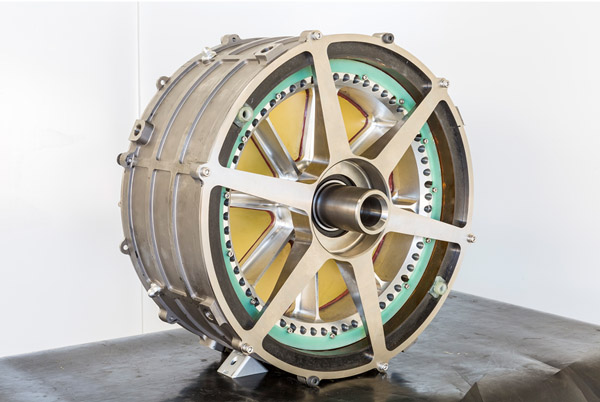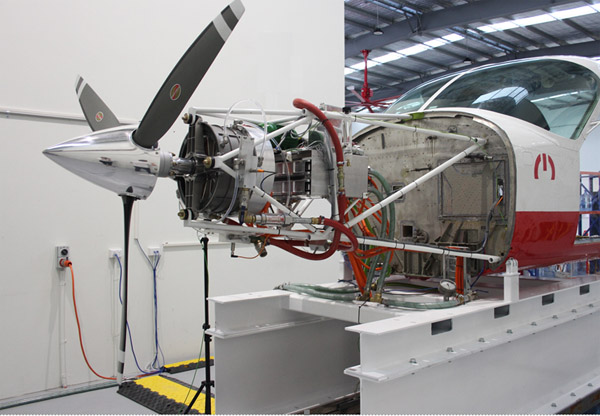|
|

|
  
Feature
brought to you in part by

Update 2019/4/2
Greening Transportation
CANADA'S FIRST ELECTRIC AIRCRAFT SET TO TAKE OFF IN 2019
By Suzanne Forcese
British Columbia's Harbour Air, the largest seaplane airline and the first fully carbon neutral airline in North America, has partnered with magniX to transform Harbour Air seaplanes into an all-electric commercial fleet powered by the magni500, a 750 horsepower all electric motor.
Harbour Air's long commitment to sustainability has been driven by their awareness that the beauty of British Columbia's coastline is a large part of the experience they offer their customers and that is why they continue to be an industry leader on sustainable initiatives such as optimizing their aircraft, actively managing flight loads, implementing paperless ticketing & web-based payroll, and recycling programs. Now they are set to soar by converting their sea planes to e-planes.
Water Today spoke with Roei Ganzarski, CEO of magniX, who is "very excited to be in partnership with Harbour Air. They have proven to be very forward thinking in their commitment to passengers while being conscious of the environment and their investment in the future. Harbour Air is the perfect partner for us because they look at doing things the right way while making life better for the communities they serve."
An all-electric fleet "will reduce the noise footprint and will eliminate any carbon footprint," said Greg MacDougall, founder and CEO of Harbour Air.

magniX
Motor
Harbour Air operates 12 routes between hubs like Seattle and Vancouver across the pristine wilderness of the Pacific Northwest. "We are making a commitment to positively impact people's lives and the environment," McDougall said. It is exactly that positive impact that motivates Ganzarski. "We are looking at the dawn of a new age," Ganzarski added. "We want to bring back connectivity of community in a way that it has never been before. 70-80% of the population live remotely removed from any major centre. That affects the prosperity of those populations. Prosperity depends on self, access to capital, and mobility. We can provide that mobility with a great service, a reasonable price, and an environmentally friendly means in the form of electric aircraft."
The trend today has been toward larger aircraft. But larger aircraft carry larger passenger loads and a larger ticket price. The smaller regional carriers are "under-utilized" Ganzarski points out. "By providing electrically operated aircraft we can reduce operating costs by 70-80% which is much more attractive to customers." So it becomes efficient, cost effective and time saving for customers who live in Kelowna for example. Instead of driving 4-5 hours to reach a destination, they can embark and disembark in an hour or less.
The aviation industry currently contributes 12 % of all North American carbon emissions and 4.9 % globally. There are few low-cost, fuel- efficient options for passenger flights under 1,000 miles. By modifying existing Harbour Air planes with innovative, all-electric magniX propulsion systems, the partnership will create the world's first completely electric seaplane fleet. This revolutionary step means a Harbour Air e-plane will have zero reliance on fossil fuels and produce zero emissions.

Electric motor in Cessna
There has been no real change in in the mechanics of flying since 1939. "Our motor provides performance and reliability. The elimination of the gear box has reduced the weight of the aircraft drastically." For aircraft weight is critical.
Electric motors are not new but what sets the magni 500 apart and ahead of the pack is a combination of advanced electromagnetic designs and materials, optimised motor topology, and a proprietary cooling system to deliver exceptional power and torque density with great efficiency. "We are using water in a unique way that does not add to the weight of the aircraft. The integrated cooling system therefore is not penalized by the heaviness of water." Ganzarski says.
The magni propulsion systems push the boundaries of what can be achieved by permanent magnet systems. Unlike conventional permanent magnet motors that require a gradual buildup of torque to meet their application range, according to Ganzarski, the magni instantly delivers the necessary torque, at "1900 RPN's compared to your middle-mile propeller aircraft of 10-30 thousand RPN's."
The electric propulsion includes the motor, motor controller/inverter, and Xbrain control system. The Xbrain is the intelligent control unit which ensures reliable operation of the magniX electric propulsion. This control unit uses advanced algorithms to manage the system's operations. Xbrain provides maximum reliability in all conditions. Performance is monitored in real-time to provide system feedback for optimal operation and data for predictive maintenance.
When Water Today asked how Ganzarski viewed the magniX-Harbour Air Venture as "revolutionary" his response was "We are challenging the status quo. The technology is radical. People are used to seeing gas guzzling, heavy aircraft. But we can do it better, lighter, safer and cleaner. We are also revolutionary because we are not it for the money. None of our employees owns any shares in the business. I don't own any shares in the business. We are all in this to make a difference. magniX is a business anchored in values and inspired by a belief that the impossible is possible."
What about safety? There is an aspect of reliability in the magni 500 that does not exist in combustion aircraft. In a combustion aircraft if there is a major issue the pilot has to turn off the engine in order to divert disaster. With the electric motor there are 4 separate motor parts. In the event of a problem the software allows the pilot to shut off one part which enables the aircraft to continue flying at 75% capacity. Should another issue arise the 2nd motor part could be disengaged to allow 50% flying capacity.
The first aircraft to be converted will be the DHC-2 de Havilland Beaver, a 6 passenger commercial aircraft used across Harbour Air's route network. Harbour Air and magniX expect to conduct the first flight tests of the all-electric aircraft in November 2019 with fully scheduled passenger flights set for take-off in 2022.
"There are certain regulatory certifications that have to be satisfied to prove both to Transport Canada and the Federal Aviation Administration– and to us too – that we are meeting all safety standards." Certification is expected in 2021.
In 2018, 75% of all airline flights world-wide were 1,000 miles or less. In Ganzarski's viewfinder by 2025 the majority of North American flights under 500 miles will be all-electric. "There is no reason not to," he says. "By 2030 all flights under 1,000 miles will be all-electric. And within the next 20-30 years we are going to see vertical take-offs and landings because it is much more accurate."
"Of course there are the naysayers – and they are right in today's time frame. It just has to become a reality to people. Look at cars. When Tesla first introduced the electric car it was only capable of short range trips but suddenly 6 years later every car manufacturer has at least one line of electric cars."
Technology has not advanced enough to make electric planes possible for long-haul flight because the batteries required would be too heavy - that's why Harbour Air is an ideal partner. But there are new battery capabilities emerging and that together with our propulsion system will transform the industry."
Thomas Edison said, "There's a way to do it better - find it." Harbour Air and magniX are doing just that as they propel their visionary partnership forward.
Harbour Air was founded in 1982 with two small sea-planes. Today it is the largest seaplane airline in North America and the first to be fully carbon-neutral carrier.
magniX is headquartered in Remond, WA with engineering facilities in Remond and in Australia. Using proprietary technology, maniX offers a range of solutions for various aviation applications.
suzanne@watertoday.ca
|
|
|
Have a question? Give us a call 613-501-0175
All rights reserved 2025 - WATERTODAY - This material may not be reproduced in whole or in part and may not be distributed,
publicly performed, proxy cached or otherwise used, except with express permission.
|
| |